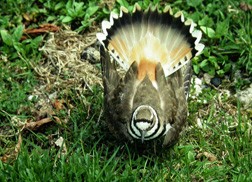The Killdeer
- Share
- Tweet
- Pin
- Share
Birds of my childhood have been on my mind lately, especially on Mother’s Day. I try to visualize the bird songs that helped to awaken me on a summer morning when I was a young boy growing up in Kewaunee. It was the “Jenny” Wrens that invariably were my alarm clock.
We could always depend on at least one or two pairs nesting within 50 feet of the south upstairs bedroom where I slept. And what great pride my dad took in the large, homemade Purple Martin house he had erected in the middle of our large vegetable garden.

A Killdeer stands tall on tip-toes, ready to run quite smoothly as if on wheels.
Some of our neighbors also had Purple Martin houses, so you can imagine the comforting, liquid-like, gurgling music of their singing that laced the warm June air – and they invariably were on the wing well before we awoke. How we loved those birds with their songs and skillful aerial maneuvers.
The Killdeer, however, left the most lasting impression on me. I was four years old in 1933 when we moved into our new brick home on Wisconsin Avenue, and it was only a few years after that a pair of the talkative plovers nested between two of the rows of peas in our garden.
Time and again my mother took us four boys into the back yard where we could sit on the sloping lawn next to the west side of the garage. There, within about 30 feet of the ringed plovers’ nest, we’d quietly watch the antics of the devoted parents. It was then and there that my great fondness for the Killdeer began to grow.
Several years ago Charlotte and I were with our nature class along the rocky beach, leading to Carlin’s Point, at Jackson Harbor on Washington Island. It was easy to remember and relate to our class one of the most awesome bird experiences I have ever had, one involving a Killdeer.
The Wisconsin Chapter of The Nature Conservancy had asked me to lead an afternoon hike at the Jackson Harbor Ridges in early June of 1970. The fact that I had not been there for a few years prompted me to take the first morning ferry to the island so I could spend several hours by myself reviewing the plant and bird life at Jackson Harbor before the group of about 25 people arrived.
It was midmorning as I slowly made my way along the stretch of cobblestone beach leading to Carlin’s Point when I was suddenly brought to attention by the frantic cries of a Killdeer. “Kill-DEE, kill-DEE, kill-DEE” the bird screamed over and over as I approached. Then the bird went into its so-called broken-wing act (which today the animal behaviorists simply refer to as a distraction display), convincing me that its nest was nearby.

The rich rufous tail of the Killdeer is raised in warning.
Walking carefully and scanning the ground, I made a mental note to alert my hiking group later in the day to be on the lookout for the Killdeer eggs. Unfortunately I became so deeply engrossed with many exciting plant discoveries during the afternoon outing that I completely forgot about the Killdeer.
Suddenly without warning, the loud resounding “Kill-DEE” call was made – and just that fast I screamed at the top of my lungs: “Stop in your tracks! Do not move one inch! We may be dangerously close to the Killdeer’s nest!” Slowly one of the men raised his hand and announced: “Roy, you aren’t going to believe this, but look what I have found!”
As I had warned the people to do, he too had stopped immediately – and there, between his two feet, was the nest of four Killdeer eggs. He had come within inches of stepping on them.
What uncanny ESP, or whatever you may wish to call it, may have existed that day between the bird and me and the people hiking with me. In reconstructing the incident, I believe that the Killdeer had momentarily left the nest to feed and had disappeared around the point.
By the time it had returned to the nest, our group had already walked well into the bird’s hallowed territory, and all the bird could do was utter its ringing, far-reaching cries of alarm. Fortunately they proved to be effective, and the only thing that Killdeer owned, its eggs, had been saved from destruction.
What continues to greatly impress me are the Killdeers’ (and other birds’) absolute simple requirements for living. A sun-drenched rocky beach, a graveled roadside ditch, or a hot arid dolostone flat for their nest along with scores of insects to eat – including beetles, grasshoppers, ants and flies – fulfill their basic needs.
Wonderful enjoyment and lessons for our own lives may come from the Killdeer, a bird that does nothing whatever to damage the environment. What fine examples they offer for us to follow!

The blotched, splashed, cryptographic camouflage of Killdeer eggs makes them hard to see.
Today as I write this, the day after Mother’s Day, it’s a simple matter to reflect with thankfulness at my mother’s excellent guidance to my brothers and me about 77 years ago. She had taught us to be highly tolerant and respectful of nesting birds.
The Killdeer, America’s most well known and loved plover, will always remain one of my all-time favorite birds – especially when hiking along the cobblestone beach at the outstanding Jackson Harbor Ridges on Washington Island.
